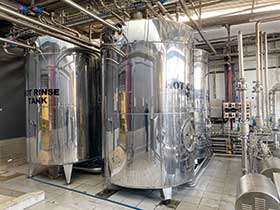

Hybrid automation was approached by one of its clients to work on a CIP upgrade project for a food production plant based on the East Rand of Johannesburg. The plant had an existing CIP system, which had drawbacks in terms of effectiveness, safety risks and excessive operation costs.
Principle of operation
The CIP plant operates by making up CIP medium into 6000 litre tanks, which contain cold water, hot water and CIP chemical solution. Once the CIP medium is prepared to the desired specifications, it is supplied via a storage tank to the factory equipment being cleaned. The storage tank has a return pump on the outlet to return the dirty water back to the CIP plant. This water, depending on its conductivity, will either go to drain or it will be recovered back into the CIP makeup tanks.
Challenges and solutions
The client had a number of challenges with regards to the existing CIP system:
Non-effective CIP
The existing CIP system was not effective in terms of cleaning equipment to desired standards and as a result the client had lost money in the market due to products failing to comply with certain food safety standards. This was the major factor contributing towards the upgrade project.
The upgraded CIP plant is equipped with high quality and reliable conductivity sensors that monitor all parameters during CIP make up and operation, therefore the equipment being cleaned is monitored to ensure effectiveness. The whole cleaning philosophy of the plant therefore evolved from being time-based on the old system to being effectiveness-based on the new one.
CIP cross contamination
Separation of CIP medium and product is very vital. The client had challenges in the past whereby these two mixed, which is also a quality compliance risk. To resolve the problem, the plant could only be cleaned on non-production days – mainly weekends.
The new design completely isolated CIP from production by the use of smart swing bend panels, which use inductive proximity sensors to detect port connections. The control system uses this information to manage all the relevant system interlocks to prevent cross contamination and most importantly, to ensure safety. This allows individual production plants to be cleaned independently during normal production days, without the possibility of getting CIP medium into other machinery that is in production mode.
Excessive operating costs
Apart from production time lost during plant CIP, there is a significant cost associated with running a CIP plant i.e., cost of chemicals, water bills, electrical bills etc. The old CIP system took longer as it was manually operated and the cost of chemicals was high as there was no recovery of CIP medium, everything was just going down the drain.
Generally, CIP process in a plant of this magnitude uses excessive amounts of water and consumes energy to heat it to the desired temperature. In addition, CIP chemicals are costly. The upgraded CIP is designed in such a way that CIP return from the equipment being cleaned can be recovered into the
CIP tanks rather than going to drain, which is an additional benefit to the client. The upgraded CIP system is also fully automated, which makes it easy to use and it lessens plant downtime.
The benefits
The primary goal of the project was to deliver an effective and efficient CIP solution. Therefore, throughout the commissioning phase and project signoff, the client’s quality department performed quality checks on every piece of equipment being cleaned, before and after CIP. The results came back positive, which proved that the new CIP system is effective and based on an efficient philosophy.
| Tel: | +27 31 573 2795 |
| Email: | [email protected] |
| www: | www.hybridautomation.co.za |
| Articles: | More information and articles about Hybrid Automation |

© Technews Publishing (Pty) Ltd | All Rights Reserved